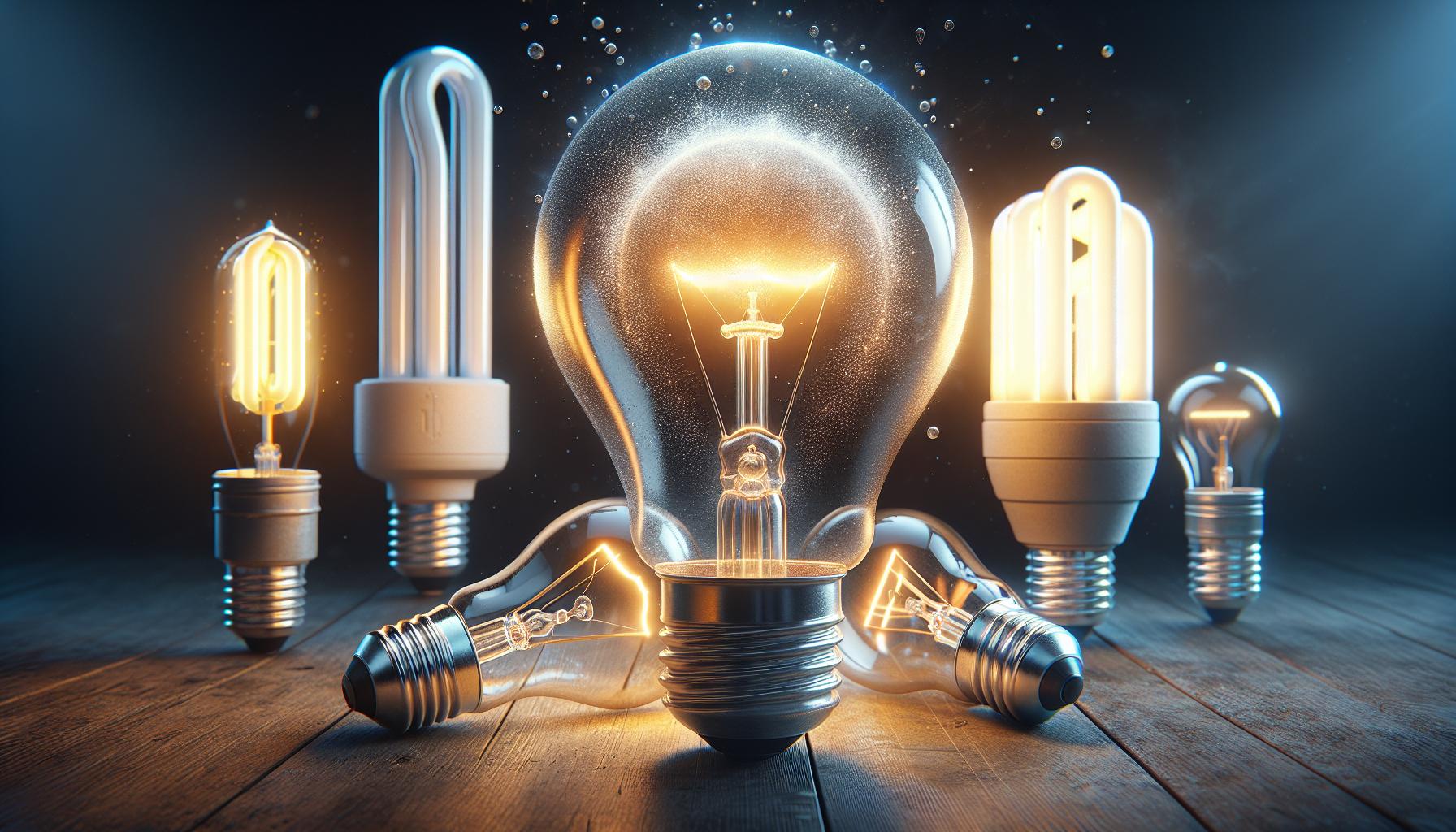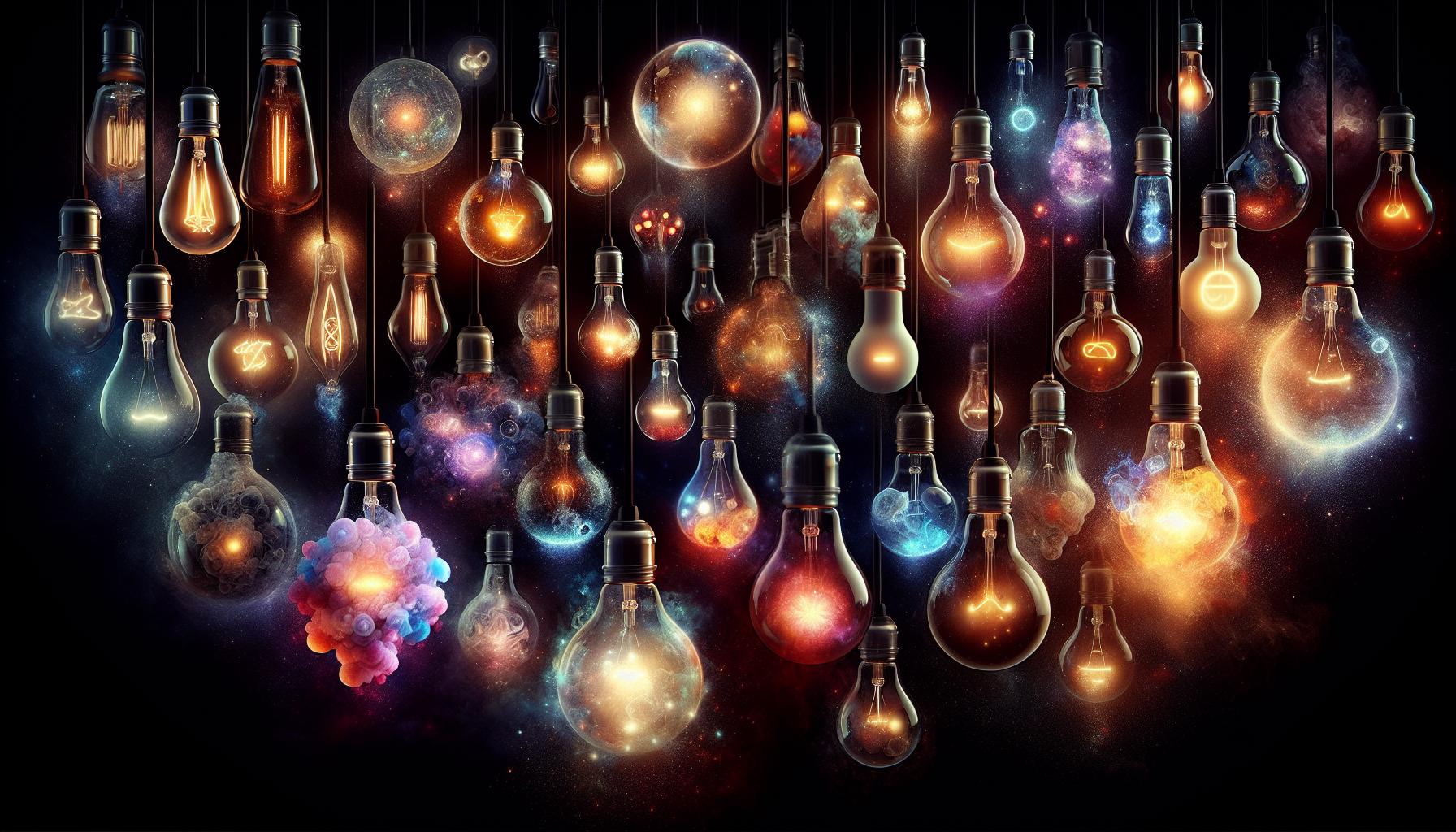Ever wondered what’s inside a light bulb? It’s not just about the glass and the glow. In fact, gas plays a pivotal role in lighting up your world. From the cozy corners of your living room to the bright lights of the city, gas-filled bulbs are everywhere.
But what kind of gas, and why is it even there? You might be surprised to learn that it’s not just to fill the void. The type of gas and its purpose can vary, adding a layer of science to the everyday object you thought you knew so well.
What’s Inside a Light Bulb?
Ever peeked inside a light bulb and wondered what’s going on in there? It’s not just about the glass and the metal contacts. Inside that familiar shape, there’s a whole world of science at play, which you, as a lighting aficionado and DIY enthusiast, will find intriguing.
First up, let’s talk about the filament. In incandescent bulbs, the filament is that tiny wire you see coiled inside, which glows to emit light. When you flick that switch, electric current heats the filament up, and voila! You’ve got light. Now, in the case of halogen lamps, there’s still a filament, but it’s encased in a much smaller quartz envelope, and it operates at a higher temperature, which usually means a brighter, whiter light for your space.
Moving on, your journey to unraveling the mysteries of light bulbs can’t miss the gas component. You might be surprised, but yes, many bulbs are filled with gases like argon, krypton, or sometimes a mix. These noble gases have superpowers – they protect the filament, prevent oxidation, and extend the life of your bulb. That’s important whether you’re illuminating your kitchen or accenting your living room with ambient lighting.
In the realm of fluorescent bulbs, the story shifts. These tubes or spirals are filled with mercury vapor. When electricity passes through, it causes the mercury gas to emit ultraviolet light, which then causes a phosphor coating on the inside of the bulb to glow. Neat, isn’t it?
Lastly, if we step into the future with LEDs, it’s a different tale. There’s no gas in these guys. LEDs use solid-state technology to produce light, which means your energy consumption drops and your bulb’s lifespan leaps up dramatically.
By understanding what goes into each light bulb type, your DIY projects just got more interesting as you can tailor your lighting choices to the needs of your space and the ambiance you want to create. From creating a cozy nook with a soft glow to lighting up your workshop with brilliant clarity, it’s all in the bulb, and now you’re in the know.
Importance of Gas in Light Bulbs
When you’re working on DIY projects at home, lighting is not just about ambiance—it’s about efficacy and longevity too. Gas plays a crucial role in the performance of many types of light bulbs. In incandescent and halogen bulbs, gases like argon and krypton are used to surround the filament. This inert atmosphere performs several vital functions; it prevents the filament from oxidizing too quickly, which would shorten the bulb’s lifespan. Moreover, these gases conduct heat, which helps in controlling the temperature of the filament.
You might not think much about the air inside your bulbs, but gas-filled bulbs tend to be more efficient. They provide brighter light and last longer than if they were to operate in a vacuum. This is especially important in halogen bulbs, where higher temperatures mean brighter light. Here, the gas preserves the filament even at these extreme conditions, ensuring that your bulb doesn’t just burn out after a few hours of use.
Now let’s talk about fluorescent bulbs. They contain a low-pressure mercury vapor; when electricity is applied, this vapor generates ultraviolet light. This UV light is then transformed into visible light as it strikes the phosphor coating inside the bulb. It’s an elegant dance of science inside a glass tube! Without this gas, the conversion to visible light wouldn’t occur, and your room would look quite dim indeed.
Transitioning to LED bulbs, you’ll notice they’re an outlier because they don’t have gas inside them. Instead, LEDs use solid-state technology to produce light—a completely different approach. While they don’t use gas to generate light, they benefit from some of the same principles when it comes to managing heat, which is pivotal for LED performance and durability.
Whether it’s a cozy corner lamp or a bright kitchen light, understanding the role of gas in bulbs can help you make the best choice for your project. Each type of bulb turns electricity into light in its unique way, and it’s these inner workings that affect how the light performs in your space.
Different Types of Gas in Light Bulbs
« Can You Use a Regular Light Bulb in an Oven? The Safety Truth Revealed
When Did Light Bulbs Become Common? The Surprising History Revealed »
When you’re knee-deep in a home DIY lighting project, knowing the various gases that light up your life can be both fascinating and practical. A few puffs of the right gas can be the difference between a cozy reading nook and a stark, unwelcoming space.
Most commonly, argon is used in light bulbs. It’s an inert gas, which means that it doesn’t react with the filament even at high temperatures. This extends the life of the bulb by preventing the filament from oxidizing too quickly. Argon is a cost-effective option that brings efficacy to your everyday incandescent bulbs.
Looking for something a bit more upscale? That’s where krypton comes into play. It’s denser than argon, meaning it allows for an even stronger barrier against filament oxidation. Bulbs filled with krypton gas shine a tad brighter and last longer, making them a top choice for those looking to invest in quality illumination.
In more specialized arenas, neon often steals the spotlight. Recognizable by its red-orange glow, neon is used in — you guessed it — neon signs. While not standard inside the bulbs in your table lamp, neon’s role in creating captivating visuals can’t go unnoticed. It’s the gas that turns an ordinary glass tube into an art piece.
Let’s shift focus to the noble xenon. This gas is used in various high-end applications such as flash bulbs and headlights. Xenon produces a bright, white light that’s closer to natural sunlight and is incredibly efficient. Due to its heavy weight, it’s highly resistant to the flow of current, thereby minimizing filament wear over time.
Understanding the key role that these gases play in your light bulbs can empower you to make savvy choices that suit your specific needs. Whether it’s the efficiency of argon, the longevity of krypton, the artistry of neon, or the natural illumination from xenon, it’s clear that these invisible elements have a substantial impact on your living space’s ambience. Keep these facts in mind as you tackle your next lighting project, and watch your space transform.
The Purpose of Gas in Light Bulbs
You might wonder why gas plays such an integral role in the life of a light bulb. Imagine your favorite cozy reading nook. The light that allows you to comfortably plunge into your latest novel isn’t just a product of electric magic; it’s also thanks to the gas inside the bulb.
Gas enhances the longevity and efficacy of light bulbs. Argon and krypton, for instance, create an environment less hospitable to filament oxidation—a common cause of bulb failure. This means that with these noble gases at play, your bulbs not only burn brighter but also say goodbye less frequently, saving you both time and money.
And it doesn’t stop there. The gas within also serves as a conductor of heat. By effectively dispersing the heat away from the filament, it helps maintain an acceptable operating temperature. This not only reduces the risk of overheating but also contributes to the overall efficiency of the bulb.
Consider the differently treated gases like tools in your DIY kit. Each has its own specialty. Neon and xenon, for example, are often used in specialized lighting due to their unique color properties, creating lights that aren’t just functional but also a treat to the eyes. Your decorative lighting or that impressive sign down the street likely owes its vibrancy to these gases.
As you begin to understand the various roles that gas plays in your light bulbs, you’re equipped to make more informed decisions for your lighting projects. Whether it’s picking the right bulb for your task lighting or creating a mood with ambiance lighting, remember that the gas inside is working hard to deliver the results you need. With knowledge of what goes on behind that luminous glow, you’re well on your way to mastering the art of lighting your home.
Conclusion
So there you have it! The gas inside your light bulbs isn’t just there to fill space—it’s a crucial player in the bulb’s performance and lifespan. By preventing oxidation and efficiently conducting heat, these gases help your bulbs shine brighter and last longer. Next time you’re picking out light bulbs, you’ll know that what’s inside matters just as much as the wattage or the brand. Happy lighting!
Frequently Asked Questions
What role does gas play in light bulbs?
Gas in light bulbs serves to prolong the bulb’s life and increase its efficiency. It prevents filament oxidation and helps conduct heat effectively.
Which gases are commonly used in light bulbs?
Common gases used in light bulbs include argon, krypton, neon, and xenon, each offering distinct advantages.
How does gas prevent filament oxidation in light bulbs?
Gas prevents filament oxidation by providing an inert environment that reduces the chemical reactions which would otherwise shorten the filament’s lifespan.
Why is it important to choose the right type of gas for a light bulb?
Choosing the right gas for a light bulb is crucial because different gases can affect the bulb’s brightness, energy efficiency, longevity, and operating temperature.
Can gas choice impact the quality of light produced by a bulb?
Yes, the choice of gas can influence the color temperature and brightness of the light emitted, thereby affecting the quality of light produced by the bulb.




